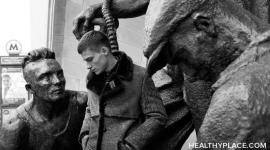Depression: What Every Woman Should Know
 Major depression and dysthymia affect twice as many women as men. This two-to-one ratio exists regardless of racial and ethnic background or economic status. The same ratio has been reported in ten other countries all over the world.12 Men and women have about the same rate of bipolar disorder (manic-depression), though its course in women typically has more depressive and fewer manic episodes. Also, a greater number of women have the rapid cycling form of bipolar disorder, which may be more resistant to standard treatments.5
Major depression and dysthymia affect twice as many women as men. This two-to-one ratio exists regardless of racial and ethnic background or economic status. The same ratio has been reported in ten other countries all over the world.12 Men and women have about the same rate of bipolar disorder (manic-depression), though its course in women typically has more depressive and fewer manic episodes. Also, a greater number of women have the rapid cycling form of bipolar disorder, which may be more resistant to standard treatments.5
A variety of factors unique to women's lives are suspected to play a role in developing depression. Research is focused on understanding these, including: reproductive, hormonal, genetic or other biological factors; abuse and oppression; interpersonal factors; and certain psychological and personality characteristics. And yet, the specific causes of depression in women remain unclear; many women exposed to these factors do not develop depression. What is clear is that regardless of the contributing factors, depression is a highly treatable illness.
The Many Dimensions of Depression in Women
Investigators are focusing on the following areas in their study of depression in women:
The Issues of Adolescence
Before adolescence, there is little difference in the rate of depression in boys and girls. But between the ages of 11 and 13 there is a precipitous rise in depression rates for girls. By the age of 15, females are twice as likely to have experienced a major depressive episode as males.2 This comes at a time in adolescence when roles and expectations change dramatically. The stresses of adolescence include forming an identity, emerging sexuality, separating from parents, and making decisions for the first time, along with other physical, intellectual, and hormonal changes. These stresses are generally different for boys and girls, and may be associated more often with depression in females. Studies show that female high school students have significantly higher rates of depression, anxiety disorders, eating disorders, and adjustment disorders than male students, who have higher rates of disruptive behavior disorders.6
Adulthood: Relationships and Work Roles
Stress in general can contribute to depression in persons biologically vulnerable to the illness. Some have theorized that higher incidence of depression in women is not due to greater vulnerability, but to the particular stresses that many women face. These stresses include major responsibilities at home and work, single parenthood, and caring for children and aging parents. How these factors may uniquely affect women is not yet fully understood.
For both women and men, rates of major depression are highest among the separated and divorced, and lowest among the married, while remaining always higher for women than for men. The quality of a marriage, however, may contribute significantly to depression. Lack of an intimate, confiding relationship, as well as overt marital disputes, have been shown to be related to depression in women. In fact, rates of depression were shown to be highest among unhappily married women.
Reproductive Events
Women's reproductive events include the menstrual cycle, pregnancy, the postpregnancy period, infertility, menopause, and sometimes, the decision not to have children. These events bring fluctuations in mood that for some women include depression. Researchers have confirmed that hormones have an effect on the brain chemistry that controls emotions and mood; a specific biological mechanism explaining hormonal involvement is not known, however.
Many women experience certain behavioral and physical changes associated with phases of their menstrual cycles. In some women, these changes are severe, occur regularly, and include depressed feelings, irritability, and other emotional and physical changes. Called premenstrual syndrome (PMS) or premenstrual dysphoric disorder (PMDD), the changes typically begin after ovulation and become gradually worse until menstruation starts. Scientists are exploring how the cyclical rise and fall of estrogen and other hormones may affect the brain chemistry that is associated with depressive illness.10
Postpartum mood changes can range from transient "baby blues" immediately following childbirth to an episode of major depression to severe, incapacitating, psychotic depression. Studies suggest that women who experience major depression after childbirth very often have had prior depressive episodes even though they may not have been diagnosed and treated.
Pregnancy (if it is desired) seldom contributes to depression, and having an abortion does not appear to lead to a higher incidence of depression. Women with infertility problems may be subject to extreme anxiety or sadness, though it is unclear if this contributes to a higher rate of depressive illness. In addition, motherhood may be a time of heightened risk for depression because of the stress and demands it imposes.
Menopause, in general, is not asssociated with an increased risk of depression. In fact, while once considered a unique disorder, research has shown that depressive illness at menopause is no different than at other ages. The women more vulnerable to change-of-life depression are those with a history of past depressive episodes.
Specific Cultural Considerations
As for depression in general, the prevalence rate of depression in African American and Hispanic women remains about twice that of men. There is some indication, however, that major depression and dysthymia may be diagnosed less frequently in African American and slightly more frequently in Hispanic than in Caucasian women. Prevalence information for other racial and ethnic groups is not definitive.
Possible differences in symptom presentation may affect the way depression is recognized and diagnosed among minorities. For example, African Americans are more likely to report somatic symptoms, such as appetite change and body aches and pains. In addition, people from various cultural backgrounds may view depressive symptoms in different ways. Such factors should be considered when working with women from special populations.
Victimization
Studies show that women molested as children are more likely to have clinical depression at some time in their lives than those with no such history. In addition, several studies show a higher incidence of depression among women who have been raped as adolescents or adults. Since far more women than men were sexually abused as children, these findings are relevant. Women who experience other commonly occurring forms of abuse, such as physical abuse and sexual harassment on the job, also may experience higher rates of depression. Abuse may lead to depression by fostering low self-esteem, a sense of helplessness, self-blame, and social isolation. There may be biological and environmental risk factors for depression resulting from growing up in a dysfunctional family. At present, more research is needed to understand whether victimization is connected specifically to depression.
Poverty
Women and children represent seventy-five percent of the U.S. population considered poor. Low economic status brings with it many stresses, including isolation, uncertainty, frequent negative events, and poor access to helpful resources. Sadness and low morale are more common among persons with low incomes and those lacking social supports. But research has not yet established whether depressive illnesses are more prevalent among those facing environmental stressors such as these.
Depression in Later Adulthood
At one time, it was commonly thought that women were particularly vulnerable to depression when their children left home and they were confronted with "empty nest syndrome" and experienced a profound loss of purpose and identity. However, studies show no increase in depressive illness among women at this stage of life.
As with younger age groups, more elderly women than men suffer from depressive illness. Similarly, for all age groups, being unmarried (which includes widowhood) is also a risk factor for depression. Most important, depression should not be dismissed as a normal consequence of the physical, social, and economic problems of later life. In fact, studies show that most older people feel satisfied with their lives.
About 800,000 persons are widowed each year. Most of them are older, female, and experience varying degrees of depressive symptomatology. Most do not need formal treatment, but those who are moderately or severely sad appear to benefit from self-help groups or various psychosocial treatments. However, a third of widows/widowers do meet criteria for major depressive episode in the first month after the death, and half of these remain clinically depressed 1 year later. These depressions respond to standard antidepressant treatments, although research on when to start treatment or how medications should be combined with psychosocial treatments is still in its early stages. 4,8
Depression is a Treatable Illness
Even severe depression can be highly responsive to treatment. Indeed, believing one's condition is "incurable" is often part of the hopelessness that accompanies serious depression. Such individuals should be provided with the information about the effectiveness of modern treatments for depression in a way that acknowledges their likely skepticism about whether treatment will work for them. As with many illnesses, the earlier treatment begins, the more effective and the greater the likelihood of preventing serious recurrences. Of course, treatment will not eliminate life's inevitable stresses and ups and downs. But it can greatly enhance the ability to manage such challenges and lead to greater enjoyment of life.
The first step in treatment for depression should be a thorough examination to rule out any physical illnesses that may cause depressive symptoms. Since certain medications can cause the same symptoms as depression, the examining physician should be made aware of any medications being used. If a physical cause for the depression is not found, a psychological evaluation should be conducted by the physician or a referral made to a mental health professional.
Types of Treatment for Depression
The most commonly used treatments for depression are antidepressant medication, psychotherapy, or a combination of the two. Which of these is the right treatment for any one individual depends on the nature and severity of the depression and, to some extent, on individual preference. In mild or moderate depression, one or both of these treatments may be useful, while in severe or incapacitating depression, medication is generally recommended as a first step in the treatment.3 In combined treatment, medication can relieve physical symptoms quickly, while psychotherapy allows the opportunity to learn more effective ways of handling problems.
Antidepressant Medications
There are several types of antidepressant medications used to treat depressive disorders. These include newer medications-chiefly the selective serotonin reuptake inhibitors (SSRIs)-and the tricyclics and monoamine oxidase inhibitors (MAOIs). The SSRIs-and other newer medications that affect neurotransmitters such as dopamine or norepinephrine-generally have fewer side effects than tricyclics. Each acts on different chemical pathways of the human brain related to moods. Antidepressant medications are not habit-forming. Although some individuals notice improvement in the first couple of weeks, usually antidepressant medications must be taken regularly for at least 4 weeks and, in some cases, as many as 8 weeks, before the full therapeutic effect occurs. To be effective and to prevent a relapse of the depression, medications must be taken for about 6 to 12 months, carefully following the doctor's instructions. Medications must be monitored to ensure the most effective dosage and to minimize side effects. For those who have had several bouts of depression, long-term treatment with medication is the most effective means of preventing recurring episodes.
The prescribing doctor will provide information about possible side effects and, in the case of MAOIs, dietary and medication restrictions. In addition, other prescribed and over-the-counter medications or dietary supplements being used should be reviewed because some can interact negatively with antidepressant medication. There may be restrictions during pregnancy.
For bipolar disorder, the treatment of choice for many years has been Lithium, as it can be effective in smoothing out the mood swings common to this disorder. Its use must be carefully monitored, as the range between an effective dose and a toxic one can be relatively small. However, lithium may not be recommended if a person has pre-existing thyroid, kidney, or heart disorders or epilepsy. Fortunately, other medications have been found helpful in controlling mood swings. Among these are two mood-stabilizing anticonvulsants, carbamazepine (Tegretol®) and valproate (Depakene®). Both of these medications have gained wide acceptance in clinical practice, and valproate has been approved by the Food and Drug Administration for first-line treatment of acute mania. Studies conducted in Finland in patients with epilepsy indicate that valproate may increase testosterone levels in teenage girls and produce polycystic ovary syndrome in women who began taking the medication before age 20. 11 Therefore, young female patients should be monitored carefully by a physician. Other anticonvulsants that are being used now include lamotrigine (Lamictal®) and gabapentin (Neurontin®); their role in the treatment hierarchy of bipolar disorder remains under study.
Most people who have bipolar disorder take more than one medication. Along with lithium and/or an anticonvulsant, they often take a medication for accompanying agitation, anxiety, insomnia, or depression. Some research indicates that an antidepressant, when taken without a mood stabilizing medication, can increase the risk of switching into mania or hypomania, or of developing rapid cycling, in people with bipolar disorder. Finding the best possible combination of these medications is of utmost importance to the patient and requires close monitoring by the physician.
Herbal Therapy
In the past few years, much interest has risen in the use of herbs in the treatment of both depression and anxiety. St. John's wort (Hypericum perforatum), an herb used extensively in the treatment of mild to moderate depression in Europe, has recently aroused interest in the United States. St. John's wort, an attractive bushy, low-growing plant covered with yellow flowers in summer, has been used for centuries in many folk and herbal remedies. Today in Germany, Hypericum is used in the treatment of depression more than any other antidepressant. However, the scientific studies that have been conducted on its use have been short-term and have used several different doses.
To address increasing American interests in St. John's wort, the National Institutes of Health conducted a clinical trial to determine the effectiveness of the herb in treating adults who have major depression. Involving 340 patients diagnosed with major depression, the eight-week trial randomly assigned one-third of them to a uniform dose of St. John's wort, one-third to a commonly prescribed SSRI, and one-third to a placebo. The trial found that St. John's wort was no more effective than the placebo in treating major depression.13 Another study is looking at the effectiveness of St. John's wort for treating mild or minor depression.
Other research has shown that St. John's wort can interact unfavorably with other medications, including those used to control HIV infection. On February 10, 2000, the FDA issued a Public Health Advisory letter stating that the herb appears to interfere with certain medications used to treat heart disease, depression, seizures, certain cancers, and organ transplant rejection. The herb also may interfere with the effectiveness of oral contraceptives. Because of these potential interactions, patients should always consult with their doctors before taking any herbal supplement.
Psychotherapy for Depression
Several types of psychotherapy-or "talk therapy"-can help people with depression.
In mild to moderate cases of depression, psychotherapy is also a treatment option. Some short-term (10 to 20 week) therapies have been very effective in several types of depression. "Talking" therapies help patients gain insight into and resolve their problems through verbal give-and-take with the therapist. "Behavioral" therapies help patients learn new behaviors that lead to more satisfaction in life and "unlearn" counter-productive behaviors. Research has shown that two short-term psychotherapies, interpersonal and cognitive-behavioral, are helpful for some forms of depression. Interpersonal therapy works to change interpersonal relationships that cause or exacerbate depression. Cognitive-behavioral therapy helps change negative styles of thinking and behaving that may contribute to the depression.
Electroconvulsive Therapy
For individuals whose depression is severe or life threatening or for those who cannot take antidepressant medication, electroconvulsive therapy (ECT) is useful.3 This is particularly true for those with extreme suicide risk, severe agitation, psychotic thinking, severe weight loss or physical debilitation as a result of physical illness. Over the years, ECT has been much improved. A muscle relaxant is given before treatment, which is done under brief anesthesia. Electrodes are placed at precise locations on the head to deliver electrical impulses. The stimulation causes a brief (about 30 seconds) seizure within the brain. The person receiving ECT does not consciously experience the electrical stimulus. At least several sessions of ECT, usually given at the rate of three per week, are required for full therapeutic benefit.
Treating Recurrent Depression
Even when treatment is successful, depression may recur. Studies indicate that certain treatment strategies are very useful in this instance. Continuation of antidepressant medication at the same dose that successfully treated the acute episode can often prevent recurrence. Monthly interpersonal psychotherapy can lengthen the time between episodes in patients not taking medication.
The Path to Healing
Reaping the benefits of treatment begins by recognizing the signs of depression. The next step is to be evaluated by a qualified professional. Although depression can be diagnosed and treated by primary care physicians, often the physician will refer the patient to a psychiatrist, psychologist, clinical social worker, or other mental health professional. Treatment is a partnership between the patient and the health care provider. An informed consumer knows her treatment options and discusses concerns with her provider as they arise.
If there are no positive results after 2 to 3 months of treatment, or if symptoms worsen, discuss another treatment approach with the provider. Getting a second opinion from another health or mental health professional may also be in order.
Here, again, are the steps to healing:
- Check your symptoms against this list.
- Talk to a health or mental health professional.
- Choose a treatment professional and a treatment approach with which you feel comfortable.
- Consider yourself a partner in treatment and be an informed consumer.
- If you are not comfortable or satisfied after 2 to 3 months, discuss this with your provider. Different or additional treatment may be recommended.
- If you experience a recurrence, remember what you know about coping with depression and don't shy away from seeking help again. In fact, the sooner a recurrence is treated, the shorter its duration will be.
Depressive illnesses make you feel exhausted, worthless, helpless, and hopeless. Such feelings make some people want to give up. It is important to realize that these negative feelings are part of the depression and will fade as treatment begins to take effect.
Self-Help for Treatment of Depression
Along with professional treatment, there are other things you can do to help yourself get better. If you have depression, it may be extremely difficult to take any action to help yourself. But it is important to realize that feelings of helplessness and hopelessness are part of the depression and do not accurately reflect actual circumstances. As you begin to recognize your depression and begin treatment, negative thinking will fade.
To help yourself:
- Engage in mild activity or exercise. Go to a movie, a ballgame, or another event or activity that you once enjoyed. Participate in religious, social or other activities.
- Set realistic goals for yourself.
- Break up large tasks into small ones, set some priorities and do what you can as you can.
- Try to spend time with other people and confide in a trusted friend or relative. Try not to isolate yourself, and let others help you.
- Expect your mood to improve gradually, not immediately. Do not expect to suddenly "snap out of" your depression. Often during treatment for depression, sleep and appetite will begin to improve before your depressed mood lifts.
- Postpone important decisions, such as getting married or divorced or changing jobs, until you feel better. Discuss decisions with others who know you well and have a more objective view of your situation.
- Remember that positive thinking will replace negative thoughts as your depression responds to treatment.
Where to Get Help for Depression
If unsure where to go for help, ask your family doctor, OB/GYN physician, or health clinic for assistance. You can also check the Yellow Pages under "mental health," "health," "social services," "suicide prevention," "crisis intervention services," "hotlines," "hospitals," or "physicians" for phone numbers and addresses. In times of crisis, the emergency room doctor at a hospital may be able to provide temporary help for an emotional problem and will be able to tell you where and how to get further help.
Listed below are the types of people and places that will make a referral to, or provide, diagnostic and treatment services.
- Family doctors
- Mental health specialists such as psychiatrists, psychologists, social workers, or mental health counselors
- Health maintenance organizations
- Community mental health centers
- Hospital psychiatry departments and outpatient clinics
- University- or medical school-affiliated programs
- State hospital outpatient clinics
- Family service/social agencies
- Private clinics and facilities
- Employee assistance programs
- Local medical and/or psychiatric societies
If you are thinking about harming yourself, or know someone who is, tell someone who can help immediately.
- Call your doctor.
- Call 911 or go to a hospital emergency room to get immediate help or ask a friend or family member to help you do these things.
- Call the toll-free, 24-hour hotline of the National Suicide Prevention Lifeline at 1-800-273-TALK (1-800-273-8255); TTY: 1-800-799-4TTY (4889) to talk to a trained counselor.
- Make sure you or the suicidal person is not left alone.
Source: National Institute of Mental Health - 2008.
Many books have been written on major depression and bipolar disorder. The following are a few that may help you understand these illnesses better.
Andreasen, Nancy. The Broken Brain: The Biological Revolution in Psychiatry. New York: Harper & Row, 1984.
Carter, Rosalyn. Helping Someone With Mental Illness: A Compassionate Guide for Family, Friends and Caregivers. New York: Times Books, 1998.
Duke, Patty and Turan, Kenneth. Call Me Anna, The Autobiography of Patty Duke. New York: Bantam Books, 1987.
Dumquah, Meri Nana-Ama. Willow Weep for Me, A Black Woman's Journey Through Depression: A Memoir. New York: W.W. Norton & Co., Inc., 1998.
Fieve, Ronald R. Moodswing. New York: Bantam Books, 1997.
Jamison, Kay Redfield. An Unquiet Mind, A Memoir of Moods and Madness. New York: Random House, 1996.
The following three booklets are available from the Madison Institute of Medicine, 7617 Mineral Point Road, Suite 300, Madison, WI 53717, telephone 1-608-827-2470:
Tunali D, Jefferson JW, and Greist JH, Depression & Antidepressants: A Guide, rev. ed. 1997.
Jefferson JW and Greist JH. Divalproex and Manic Depression: A Guide, 1996 (formerly Valproate guide).
Bohn J and Jefferson JW. Lithium and Manic Depression: A Guide, rev. ed. 1996.
1 Blehar MC, Oren DA. Gender differences in depression. Medscape Women's Health, 1997;2:3. Revised from: Women's increased vulnerability to mood disorders: Integrating psychobiology and epidemiology. Depression, 1995;3:3-12.
2 Cyranowski JM, Frank E, Young E, Shear MK. Adolescent onset of the gender difference in lifetime rates of major depression. Archives of General Psychiatry, 2000; 57:21-27.
3 Frank E, Karp JF, and Rush AJ. Efficacy of treatments for major depression. Psychopharmacology Bulletin, 1993;29:457-75.
4 Lebowitz BD, Pearson JL, Schneider LS, Reynolds CF, Alexopoulos GS, Bruce ML, Conwell Y, Katz IR, Meyers BS, Morrison MF, Mossey J, Niederehe G, and Parmelee P. Diagnosis and treatment of depression in late life: Consensus statement update. Journal of the American Medical Association, 1997;278:1186-90.
5 Leibenluft E. Issues in the treatment of women with bipolar illness. Journal of Clinical Psychiatry (supplement 15), 1997;58:5-11.
6 Lewisohn PM, Hyman H, Roberts RE, Seeley JR, and Andrews JA. Adolescent psychopathology: 1. Prevalence and incidence of depression and other DSM-III-R disorders in high school students. Journal of Abnormal Psychology, 1993;102:133-44.
7 Regier DA, Farmer ME, Rae DS, Locke BZ, Keith SJ, Judd LL, and Goodwin FK. Comorbidity of mental disorders with alcohol and other drug abuse: Results from the epidemiologic catchment area (ECA) study. Journal of the American Medical Association, 1993;264:2511-8.
8 Reynolds CF, Miller MD, Pasternak RE, Frank E, Perel JM, Cornes C, Houck PR, Mazumdar S, Dew MA, and Kupfer DJ. Treatment of bereavement-related major depressive episodes in later life: A controlled study of acute and continuation treatment with nortriptyline and interpersonal psychotherapy. American Journal of Psychiatry, 1999;156:202-8.
9 Robins LN and Regier DA (Eds). Psychiatric Disorders in America, The Epidemiologic Catchment Area Study. New York: The Free Press, 1990.
10 Rubinow DR, Schmidt PJ, and Roca CA. Estrogen-serotonin interactions: Implications for affective regulation. Biological Psychiatry, 1998;44(9):839-50.
11 Vainionpaa LK, Rattya J, Knip M, Tapanainen JS, Pakarinen AJ, Lanning P, Tekay, A, Myllyla, VV, Isojarvi JI. Valproate-induced hyperandrogenism during pubertal maturation in girls with epilepsy. Annals of Neurology, 1999;45(4):444-50.
12 Weissman MM, Bland RC, Canino GJ, Faravelli C, Greenwald S, Hwu HG, Joyce PR, Karam EG, Lee CK, Lellouch J, Lepine JP, Newman SC, Rubin-Stiper M, Wells JE, Wickramaratne PJ, Wittchen H, and Yeh EK. Cross-national epidemiology of major depression and bipolar disorder. Journal of the American Medical Association, 1996;276:293-9.
13 Hypericum Depression Trial Study Group. Effect of Hypericum perforatum (St. John's wort) in major depressive disorder: a randomized controlled trial. Journal of the American Medical Association, 2002; 287(14): 1807-1814.
next: Taking Antidepressants During Pregnancy
~ depression library articles
~ all articles on depression
APA Reference
Tracy, N.
(2008, December 14). Depression: What Every Woman Should Know, HealthyPlace. Retrieved
on 2024, April 16 from https://www.healthyplace.com/depression/articles/depression-what-every-woman-should-know



